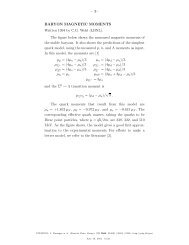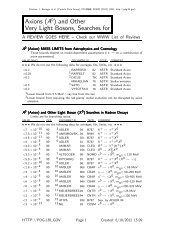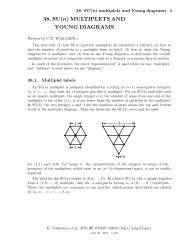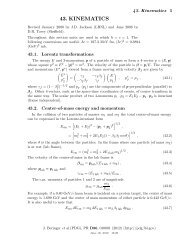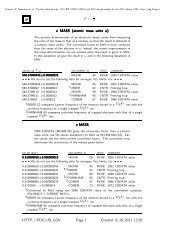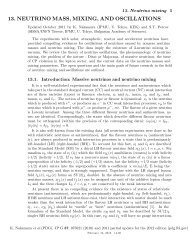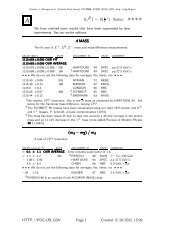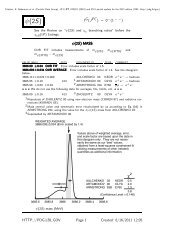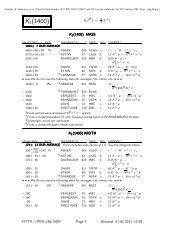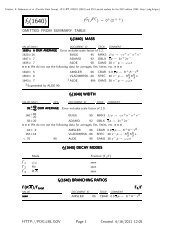Neutrino Mixing - Particle Data Group - CERN
Neutrino Mixing - Particle Data Group - CERN
Neutrino Mixing - Particle Data Group - CERN
You also want an ePaper? Increase the reach of your titles
YUMPU automatically turns print PDFs into web optimized ePapers that Google loves.
Citation: K. Nakamura et al. (<strong>Particle</strong> <strong>Data</strong> <strong>Group</strong>), JP G 37, 075021 (2010) and 2011 partial update for the 2012 edition (URL: http://pdg.lbl.gov)<br />
1 DENIZ 10 observe reactor νe e scattering with recoil kinetic energies 3–8 MeV using<br />
CsI(Tl) detectors. The observed rate is consistent with the Standard Model prediction,<br />
leading to a constraint on sin 2 θ W =0.251 ± 0.031(stat)±0.024(sys).<br />
2 Updated result of KamLAND, including the data used in EGUCHI 03. Note that the<br />
survival probabilities for different periods are not directly comparable because the effective<br />
baseline varies with power output of the reactor sources involved, and there were large<br />
variations in the reactor power production in Japan in 2003.<br />
3 EGUCHI 03 observe reactor neutrino disappearance at ∼ 180 km baseline to various<br />
Japanese nuclear power reactors.<br />
4 BOEHM 01 search for neutrino oscillations at 0.75 and 0.89 km distance from the Palo<br />
Verde reactors.<br />
5 APOLLONIO 99, APOLLONIO 98 search for neutrino oscillations at 1.1km fixed distance<br />
from Chooz reactors. They use ν e p → e + n in Gd-loaded scintillator target.<br />
APOLLONIO 99 supersedes APOLLONIO 98. See also APOLLONIO 03 for detailed<br />
description.<br />
6 GREENWOOD 96 search for neutrino oscillations at 18 m and 24 m from the reactor at<br />
Savannah River.<br />
7 DECLAIS 94 result based on integral measurement of neutrons only. Result is ratio<br />
of measured cross section to that expected in standard V-A theory. Replaced by<br />
ACHKAR 95.<br />
8 KWON 81 represents an analysis of a larger set of data from the same experiment as<br />
BOEHM 80.<br />
Atmospheric neutrinos<br />
<strong>Neutrino</strong>s and antineutrinos produced in the atmosphere induce μ-like and<br />
e-like events in underground detectors. The ratio of the numbers of the<br />
two kinds of events is defined as μ/e. It has the advantage that systematic<br />
effects, such as flux uncertainty, tend to cancel, for both experimental and<br />
theoretical values of the ratio. The “ratio of the ratios” of experimental<br />
to theoretical μ/e, R(μ/e), or that of experimental to theoretical μ/total,<br />
R(μ/total) with total = μ+e, is reported below. If the actual value is<br />
not unity, the value obtained in a given experiment may depend on the<br />
experimental conditions. In addition, the measured “up-down asymmetry”<br />
for μ (N up (μ)/N down (μ)) or e (N up (e)/N down (e)) is reported.<br />
The expected “up-down asymmetry” is nearly unity if there is no neutrino<br />
oscillation.<br />
R(μ/e) R(μ/e) =(MeasuredRatioμ/e) =(MeasuredRatioμ/e) / / (Expected (Expected Ratio Ratio μ/e)<br />
μ/e)<br />
VALUE DOCUMENT ID TECN COMMENT<br />
•••We do not use the following data for averages, fits, limits, etc. •••<br />
0.658±0.016±0.035 1 ASHIE 05 SKAM sub-GeV<br />
0.702 +0.032<br />
−0.030 ±0.101 0.69 ±0.10 ±0.06<br />
1.00 ±0.15 ±0.08<br />
2 ASHIE<br />
3 SANCHEZ<br />
4 FUKUDA<br />
5 DAUM<br />
05<br />
03<br />
96B<br />
95<br />
SKAM multi-GeV<br />
SOU2 Calorimeter raw data<br />
KAMI Water Cherenkov<br />
FREJ Calorimeter<br />
0.60 +0.06<br />
−0.05 ±0.05 6 FUKUDA 94 KAMI sub-GeV<br />
0.57 +0.08<br />
−0.07 ±0.07 7 FUKUDA 94<br />
8 BECKER-SZ... 92B<br />
KAMI<br />
IMB<br />
multi-Gev<br />
Water Cherenkov<br />
HTTP://PDG.LBL.GOV Page 2 Created: 6/16/2011 12:06



